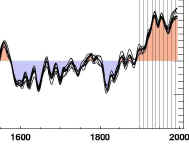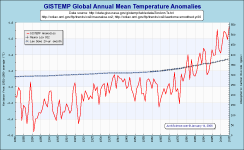JunkScience.com
February 9, 2006
Every now and then a study comes along that we just know the press will really make a hash of and in this week's edition of Science we find one with the fairly innocuous title of The Spatial Extent of 20th-Century Warmth in the Context of the Past 1200 Years by Tim Osborn and Keith Briffa. [Full Text | PDF | Supporting Online Material]
Nothing too exciting there, the abstract goes on to say "Periods of widespread warmth or cold are identified by positive or negative deviations that are synchronous across a number of temperature-sensitive proxy records drawn from the Northern Hemisphere. The most significant and longest duration feature during the last 1200 years is the geographical extent of warmth in the middle to late 20th century. Positive anomalies during 890 to 1170 and negative anomalies during 1580 to 1850 are consistent with the concepts of a Medieval Warm Period and a Little Ice Age, but comparison with instrumental temperatures shows the spatial extent of recent warmth to be of greater significance than that during the medieval period."
Still nothing too radical, while tipping the hat to both the Medieval Warm Period and Little Ice Age this suggests the Modern Warm Period to be much more pronounced in region of effect - bigger, if you prefer. And that is where the press will stop reading and start blathering about human fingerprints, greenhouse effect etc., completely missing the real story told here (well, in the supplemental information, actually). Check out the following graphic:

Figure S4. Difference between the fraction of the available records in each year that have normalised values >1 and <–1, filtered to remove variations on time scales less than 20 years. The red and blue shading shows the result using all 14 proxy records. The thin black lines indicate results obtained when each of the 14 proxies is systematically excluded from the analysis.
Never mind the quaintness of asking trees what the temperature was to tenths of a degree precision a thousand years ago, look closely at the 20th Century.

 Here's an expansion with decades roughly marked for you and, in case you haven't noticed the significance yet, to the right we have Crowley (2000) with appended Jones et al instrumental record.
Here's an expansion with decades roughly marked for you and, in case you haven't noticed the significance yet, to the right we have Crowley (2000) with appended Jones et al instrumental record.
According to 14 proxy measures combined, peak (recent) Northern Hemisphere temperatures occurred in the 1930s and 1950s, bottoming out of a cooling in the 1970s (looming ice age scare) and, by their chart, not fully recovering into the 1990s.
We've remarked before on the inappropriateness of appending instrumental amalgams on proxy records - they are simply incompatible as this study classically demonstrates.
There are some immediate takeaways from this:
- Proxy records might significantly understate temperature variation - in which case we seriously underestimate the amplitude of past temperature swings or;
- Increasing urbanisation of the near-surface temperature record is not being correctly handled and we are overestimating contemporary temperature variation or;
- Both of the above are true and we remain pretty well clueless regarding global mean temperature.
Fascinatingly, for the period of overlap between the combined proxies of Osborn and Briffa and the satellite-mounted MSU data presented by UAH, we have an apparent agreement of warming something under +0.15 °C between proxies, satellite and radiosonde balloon measures, leaving near-surface amalgams isolated in claims of 2-4 times greater warming.
 This, finally, brings us to our lead - does this let CO2 off the hook? Atmospheric CO2 records, shown at right superimposed over the House of Hansen's GISTEMP global mean temperature anomaly track, indicate little change prior to 1950, when Osborn and Briffa's proxy combo show all contemporary warming had occurred, while the greatest change in atmospheric gases occurred when, if we listen to the trees, Earth cooled and then recovered for no net change in temperature.
This, finally, brings us to our lead - does this let CO2 off the hook? Atmospheric CO2 records, shown at right superimposed over the House of Hansen's GISTEMP global mean temperature anomaly track, indicate little change prior to 1950, when Osborn and Briffa's proxy combo show all contemporary warming had occurred, while the greatest change in atmospheric gases occurred when, if we listen to the trees, Earth cooled and then recovered for no net change in temperature.
So, do we listen to trees, weather balloons and satellites, in which case we are forced to assume a very large natural component in apparent change in global climate or do we assume that a couple of guys who decline to make their data and methodology public are making a brilliant fist of eliminating urban heat island effect from the near-surface temperature amalgam and that the rest of the world, including the trees, are wrong - in which case humans dramatically warmed the planet even before significantly altering the atmospheric CO2 level. (How about that Phil? Any chance of that data and methodology escaping into the public domain mate?)
Whatever, we really can't see the media getting past "Recent warmth most widespread" or some such as a result of this study and that's a pity because they will have missed one of the biggest stories in the recent climate change kerfuffle.
Home